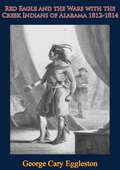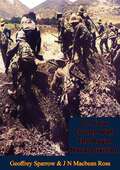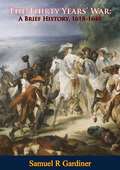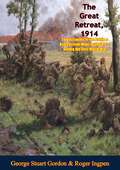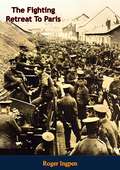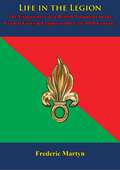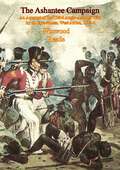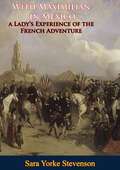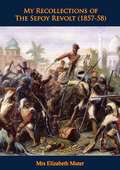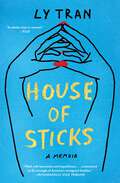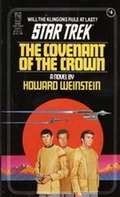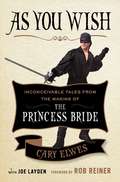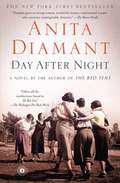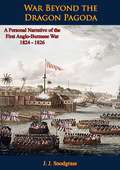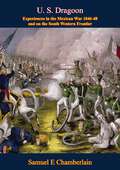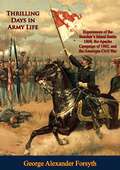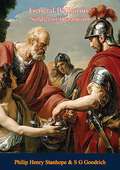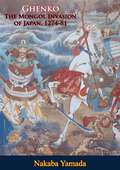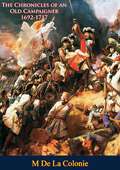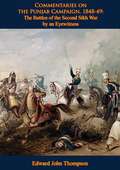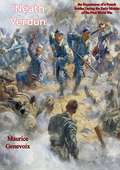- Table View
- List View
Red Eagle and the Wars with the Creek Indians of Alabama 1812-1814
by George Cary Eggleston“Red Sticks, White Sticks and the war in AlabamaThe Creek Indian War, also known as the Red Stick War, took place between 1813-1814 and has been considered by many historians as part of the War of 1812. The Creek—or Muscogee—Indians of Alabama were effectively waging a civil war among themselves. One militant faction, the so called Red Sticks, proposed an aggressive return to the traditional life of their forebears and an end to treaties with and concessions to pioneer settlers represented by the United States government. The White Sticks, opting for peace, inevitably took the opposing view. Although the conflict began as one between the indigenous Indians, American forces, under the soon to be famous Andrew Jackson among others, were drawn into the conflict because much of the animosity was focussed on pioneer settlements. The conflict started in the usual manner of American Indian Wars—with the murder of settler families. The inevitable revenge and retribution that followed—and an escalation of the kind of merciless savagery the Americans had come to expect—culminated in the massacre of 500 settlers, friendly Indians, mixed blood Creeks and soldiers at Fort Mims in an attack led by the Red Stick war leader, Red Eagle. Other forts were also attacked. Panic spread through the region exacerbated by the inability of the Federal government to provide ready aid since it was engaged against the British and their Indian allies to the east. As a consequence much of the fighting was undertaken by militias from Tennessee, Georgia and Mississippi supported by White Stick allies. National hero, Davy Crockett, also served in this conflict. The war ended in a victory for the Americans and put Andrew Jackson on a path to the presidency and the White House. It was a disaster for the entire Creek Indian tribe—irrespective of their allegiances—who paid for the conflict through the confiscation of vast tracts of their traditional lands.”-Print ed.
On Four Fronts with the Royal Naval Division
by Geoffrey Sparrow J N Macbean Ross“The Blue Jackets who fought on landThe time of Nelson was not only notable because of the success in nautical warfare of the man himself, but also because it was the zenith of the 'age of sail' that left British sea power so dominant that Britannia really did 'rule the waves.' No navy could stand against the might of the Royal Navy, and so until Jutland during the Great War it would not fight another major battle at sea. Queen Victoria's ever expanding empire meant that British forces were perpetually set against often underdeveloped powers and the navy took its part, but most of the hard work of empire building would inevitably fall upon the British army. Of course, the Royal Navy had its own 'soldiers'—the Royal Marines. The particular talents and skills of sailors were often required, particularly whilst manning 'the guns, ' so the 19th century saw the 'blue jackets' in action in the Crimean War, the Indian Mutiny, the Zulu War, the Boer War and several other conflicts. The early years of the 20th century brought a period of instability that inexorably dragged the great powers of Europe towards the cataclysm of blood which was to be the Great War of 1914-18...The Royal Naval Division was formed around a cadre of Royal Marines and sailors and was expanded as a unit of the New Army by volunteers. The Division saw action in the defence of Antwerp in 1914, on Helles and Anzac during the disastrous Gallipoli Campaign in 1915 and on the Western Front where it took part in the Battle of the Somme in 1916 and the Third Battle of Ypres in 1917. This book was written by one of the their number and is an often light-hearted account of the wartime record of the division, full of incident and anecdote and scattered with occasionally humorous line drawings. There is little in print about the Royal Naval Division in the First World War so this will make a welcome addition to any naval library.”-Print ed.
The Thirty Years' War: A Brief History, 1618-1648
by Samuel R Gardiner“A concise history of a cataclysmic European conflict in the 17th centuryThe Thirty Years' War was fought between 1618-1648 and is widely recognised as being one of the most destructive wars ever fought. More people lost their lives in this conflict, as a percentage of the total population at the time, than in the conflicts of the twentieth century. Fought principally in central Europe—and mostly over terrain now in modern day Germany—the war involved more than fifteen nation states. Forces were divided broadly on religious grounds, between Protestants and their allies and the Catholics of the Holy Roman Empire and Spain but also with elements of the Ottoman Turkish Empire. Self evidently this was a long, bloody conflict the causes of which were many and complex. Dynasties were born in its tumult, great men were brought to the fore and some, like Gustavus Adolphus of Sweden, would perish before its conclusion. The campaigns and battles of the Thirty Years' War have inspired historians across the centuries to the present day to write about them and many highly regarded works concerning the war have been published. This concise book takes a different approach; it sets out to give an understanding of the events and personalities involved and is an ideal overview for both specialists and those new to the subject.” – Print ed.
The Great Retreat, 1914: During the First World War [Illustrated Edition]
by George Stuart Gordon Roger IngpenIncludes The First World War On The Western Front 1914-1915 Illustrations Pack with 101 maps, plans, and photos.“Two views of the Great RetreatImperial Germany had long planned the conflict that was to become the First World War, but when the onslaught came there was little sign that the nations which would be embroiled were prepared for the storm. Germany advanced in the east and west where French and Belgian armies were forced to retire by overwhelming odds. The small British Army, the 'B. E. F', was rushed to the continent with most of its troops having less than a week between garrison life and the firing line. Under Sir John French, it was allocated the western end of the line, and at Mons it inflicted far more causalities on the enemy than its numbers would suggest. No army of its size, however, could stand against the German superiority in men (at least five to one) or artillery and machine guns. An envelopment was inevitable and so a stubbornly fought retreat was ordered. Near Le Cateau, the British turned at bay and Smith-Dorrien's determination to stand and fight undoubtedly saved the British Army from annihilation. Many people imagine the First World War as a stalemate of mud, wire and trenches, but in the first six months it was a great European war fought in much the same way that Napoleon, Wellington and Blucher had fought a century before.”-Print ed.
The Fighting Retreat To Paris
by Roger IngpenIncludes The First World War On The Western Front 1914-1915 Illustrations Pack with 101 maps, plans, and photos.A fascinating view of the opening phases of the First World War.“Imperial Germany had long planned the conflict that was to become the First World War, but when the onslaught came there was little sign that the nations which would be embroiled were prepared for the storm. Germany advanced in the east and west where French and Belgian armies were forced to retire by overwhelming odds. The small British Army, the 'B. E. F', was rushed to the continent with most of its troops having less than a week between garrison life and the firing line. Under Sir John French, it was allocated the western end of the line, and at Mons it inflicted far more causalities on the enemy than its numbers would suggest. No army of its size, however, could stand against the German superiority in men (at least five to one) or artillery and machine guns. An envelopment was inevitable and so a stubbornly fought retreat was ordered. Near Le Cateau, the British turned at bay and Smith-Dorrien's determination to stand and fight undoubtedly saved the British Army from annihilation. Many people imagine the First World War as a stalemate of mud, wire and trenches, but in the first six months it was a great European war fought in much the same way that Napoleon, Wellington and Blucher had fought a century before.”-Print ed.
Life in the Legion: The Experiences of a British Volunteer in the French Foreign Legion in the Late 19th Century
by Frederic MartynOn campaign under the tricolor“This is an essential book for all those interested in the French Foreign Legion because it is a brilliant first hand account written by an English 'gentleman volunteer' who experienced 'life in the legion' in the late 1880's and who had previously been a serving officer in one of the cavalry regiments of the British Army. Far from being a tale of hardship and abuse, the author had nothing but admiration for the Legion and—as an experienced soldier—obviously thoroughly enjoyed the five years he spent serving in its ranks. The writer quite simply could not have enough action and he volunteered to serve in Tonkin, Dahomey and against the Tuareg tribesmen of North Africa. In consequence this book is full of colourful and detailed campaign and battle action which is compellingly recounted by a fighting soldier more than capable of putting his engrossing story into words. Highly recommended.”-Print ed.
The Ashantee Campaign: An Account of the Third Anglo-Ashanti War by an Eyewitness, West Africa, 1873-4
by Winwood Reade“Colonial warfare on the Dark ContinentThe British Empire rapidly spread its influence throughout the globe during the nineteenth century. Predictably these intrusions rarely found favour with the indigenous populations and so, inevitably, the imperial interests of power and commerce were reinforced by the imposition of military and naval might courtesy of the British Army and the Royal Navy. British interests in West Africa proved to be no exception to the rule and the so called 'Ashanti Wars' were fought with varying degrees of savagery and through eight campaigns from 1806 until 1900. This book is about the Third Anglo-Ashanti War which was fought during 1873-74. Garnet Wolseley, commanding a force of British, West Indian and local forces marched against the Ashanti who had invaded British territory. The campaign gained particular notoriety because it occurred during the golden age of newspaper correspondents and was covered by both G. A. Henty and Henry Morton Stanley. It made Wolseley's reputation and he became a household name. The conflict was made singular by the nature of the terrain-often thick jungle-across which it was fought and by its exotic protagonists and this makes it a subject of particular interest for students of the colonial wars in the Victorian era. The outcome of the war was, perhaps, predictable and the British both occupied the enemy capital Kumasi and then burnt it down as an object lesson. This book is particularly useful because the author was an eyewitness to the storming of Amoaful by the Black Watch, the storming of Ordahsu by the Rifle Brigade and the fall of the capital.”-Print ed.
With Maximilian in Mexico: a Lady's Experience of the French Adventure
by Sara Yorke Stevenson“A remarkable experience of little reported events.The Second Empire of France was, by the early 1860's in good health. France had acquitted itself well in the Crimea and in the war against Austria. The idea of a European monarch on the throne of Mexico was not a new one. France was attracted to the idea of a 'Latin' influence in America and thus the opening chords were struck of what would eventually be—to quote the author—'A Dance of Doom', the steps of which would lead the Archduke Maximilian to a stark wall there to be riddled with bullets from a Mexican firing squad. The author of this account—a young American woman living in Paris—was swept up in these extraordinary events and found herself in Mexico amongst its most influential figures. This is her essential and riveting story of turmoil and rebellion.”- Print ed.
My Recollections of The Sepoy Revolt (1857-58)
by Mrs Elizabeth Muter“Mrs Elizabeth McMullin Muter was married to a captain of the 1st Battalion 60th King's Royal Rifles stationed in Meerut, a few hours travel east of Delhi, when the mutiny among the sepoys of the garrison broke out there on Sunday morning of May 10th, 1857. Elizabeth Muter graphically describes the horrors of those first days of the conflict from the perspective of the wives of officers who were set adrift in times of peril and uncertainty as their husbands left them to fight. This book also contains some campaign recollections by Captain Muter.”-Print ed.
House of Sticks: A Memoir
by Ly TranNew York City Book Awards Hornblower Award Winner One of Vogue and NPR&’s Best Books of the Year This beautifully written &“masterclass in memoir&” (Elle) recounts a young girl&’s journey from war-torn Vietnam to Queens, New York, &“showcas[ing] the tremendous power we have to alter the fates of others, step into their lives and shift the odds in favor of greater opportunity&” (Star Tribune, Minneapolis).Ly Tran is just a toddler in 1993 when she and her family immigrate from a small town along the Mekong river in Vietnam to a two-bedroom railroad apartment in Queens. Ly&’s father, a former lieutenant in the South Vietnamese army, spent nearly a decade as a POW, and their resettlement is made possible through a humanitarian program run by the US government. Soon after they arrive, Ly joins her parents and three older brothers sewing ties and cummerbunds piece-meal on their living room floor to make ends meet. As they navigate this new landscape, Ly finds herself torn between two worlds. She knows she must honor her parents&’ Buddhist faith and contribute to the family livelihood, working long hours at home and eventually as a manicurist alongside her mother at a nail salon in Brooklyn that her parents take over. But at school, Ly feels the mounting pressure to blend in. A growing inability to see the blackboard presents new challenges, especially when her father forbids her from getting glasses, calling her diagnosis of poor vision a government conspiracy. His frightening temper and paranoia leave a mark on Ly&’s sense of self. Who is she outside of everything her family expects of her? An &“unsentimental yet deeply moving examination of filial bond, displacement, war trauma, and poverty&” (NPR), House of Sticks is a timely and powerful portrait of one girl&’s coming-of-age and struggle to find her voice amid clashing cultural expectations.
The Covenant of the Crown (Star Trek: The Original Series #4)
by Howard WeinsteinTHE SHADDAN CROWN IS THE KEY TO POWER -- AND THE KLINGONS HAVE THE ADVANTAGE! An Enterprise shuttle is forced to crash-land in a violent storm on the barren planet Sigma 1212. Spock, McCoy and Kailyn, the beautiful heir to the Shaddan throne, survive in the near disaster. Pursued by primitive hunters and a band of Klingon scouts, they must reach the mountain where the fabulous dynastic crown is hidden. With the help of Spock and McCoy, and her own fantastic mental powers, Kailyn must prove that she alone is the true heir to the throne. Should they fail, they will open the door for Klingon takeover of the whole quadrant -- and the galaxy's hope to live long and prosper will fall in the shadow of a cruel tyranny!
Girl in the Shadows (Shadows #2)
by V.C. AndrewsSome secrets survive the light of day, others should stay lost in darkness forever—the family saga that began with April Shadows continues!April Taylor wasn't a little girl anymore—but who was she really? The home she shared with her parents and her older sister, Brenda, may have been filled with turmoil, but it was the only home she knew. Now, with nowhere to go in the wake of losing her mother and father, April had to grow up fast as she embarked on an odyssey of heartbreak and betrayal. It was mere chance that led her to the secluded home of a kindly elderly woman and her deaf teenaged granddaughter, Echo. There, April found a shelter from her mixed-up life, and from the confusion that severed her relationship with Brenda, after an encounter with Brenda's girlfriend, Celia. But when a dangerous couple arrives with greedy intentions, April discovers they will take advantage of her very special friendship with Echo to get what they want. Now, April's survival depends on being true to the one person she's never fully accepted: herself.
As You Wish: Inconceivable Tales from the Making of The Princess Bride
by Cary ElwesFrom actor Cary Elwes, who played the iconic role of Westley in The Princess Bride, comes a first-person account and behind-the-scenes look at the making of the cult classic film filled with never-before-told stories, exclusive photographs, and interviews with costars Robin Wright, Wallace Shawn, Billy Crystal, Christopher Guest, and Mandy Patinkin, as well as author and screenwriter William Goldman, producer Norman Lear, and director Rob Reiner.The Princess Bride has been a family favorite for close to three decades. Ranked by the American Film Institute as one of the top 100 Greatest Love Stories and by the Writers Guild of America as one of the top 100 screenplays of all time, The Princess Bride will continue to resonate with audiences for years to come.Cary Elwes was inspired to share his memories and give fans an unprecedented look into the creation of the film while participating in the twenty-fifth anniversary cast reunion. In As You Wish he has created an enchanting experience; in addition to never-before seen photos and interviews with his fellow cast mates, there are plenty of set secrets and backstage stories.With a foreword by Rob Reiner and a limited edition original poster by acclaimed artist Shepard Fairey, As You Wish is a must-have for all fans of this beloved film.
Seekers: Seekers #3: Long Shot (Star Trek: The Original Series #3)
by David MackThe third novel in the acclaimed Original Series-era saga Seekers, by New York Times bestselling author David Mack!SCIENCE GONE MAD…Bizarre sensor readings lead the Starfleet scout ship Sagittarius to an alien world where efforts to harness a dangerous and unstable technology have thrown the laws of probability out of balance. Now, events that might have occurred only one time in a trillion are happening constantly—to deadly and dazzling effect. A PLANET IN PERIL…As disasters and miracles multiply globally at an ever-increasing rate, it’s up to Captain Clark Terrell and his crew to shut down the experiment-gone-wrong before its storm of chaos causes the planet’s destruction. But the odds against their success—and their survival—might be too great to overcome. ™, ®, & © 2015 CBS Studios, Inc. STAR TREK and related marks are trademarks of CBS Studios, Inc. All Rights Reserved.
Capturing Angels
by V.C. AndrewsV.C. Andrews, queen of Gothic fiction for twenty-five years, explores a new genre in her women’s fiction debut—available exclusively as an eBook. A young mother struggles to keep her marriage together in the wake of her daughter’s kidnapping…and to keep hope of her return alive. Grace is the doting mother of Mary, an angelic five-year-old who charms everyone around her. But in one tragic moment at a local shopping mall, Grace looks down to discover that Mary is no longer at her side…and can&’t be found anywhere. She and her husband wait by the phone for a ransom demand that never comes. For months Grace believes that Mary is somewhere, alive and safe, waiting to come home to her—but as her family and friends give up hope, Grace&’s marriage begins to crumble. Only one detective, Sam Abraham, shares her determination to find Mary…but could his motives be less than altruistic? As Sam and Mary work together to track Mary&’s disappearance, they discover clues that this was more than a random kidnapping—and that Mary may have been special to more than just her mother…
Scattered Leaves (Early Spring)
by V.C. AndrewsShe was supposed to be hidden away. But when the truth is exposed, she can't stay silent...After tragedy tears her family apart, Jordan March is shipped off by her domineering Grandmother Emma to live with Emma's long-forgotten sister. Shuttered in a rundown farmhouse, Aunt Frances is the strangest person Jordan has ever met. Why has Grandmother hidden away this fragile, harmless woman—did Frances grow up much too fast, like Jordan did? In the shadows of the farmhouse, Jordan is about to unearth the shattering truth—and the March family will never be the same...
Day After Night: A Novel
by Anita DiamantNamed a Best Book of the Year by The Washington Post and The Salt Lake Tribune Just as she gave voice to the silent women of the Hebrew Bible in The Red Tent, Anita Diamant creates a cast of breathtakingly vivid characters—young women who escaped to Israel from Nazi Europe—in this intensely dramatic novel.Day After Night is based on the extraordinary true story of the October 1945 rescue of more than two hundred prisoners from the Atlit internment camp, a prison for “illegal” immigrants run by the British military near the Mediterranean coast south of Haifa. The story is told through the eyes of four young women at the camp who survived the Holocaust: Shayndel, a Polish Zionist; Leonie, a Parisian beauty; Tedi, a hidden Dutch Jew; and Zorah, a concentration camp survivor. Haunted by unspeakable memories and losses, afraid to hope, the four of them find salvation in the bonds of friendship and shared experience even as they confront the challenge of re-creating themselves in a strange new country. Diamant’s triumphant novel is an unforgettable story of tragedy and redemption that reimagines a singular moment in history with stunning eloquence.
War Beyond the Dragon Pagoda: A Personal Narrative of the First Anglo-Burmese War 1824 - 1826
by J. J. Snodgrass“The author—a staff officer—who was an eyewitness to most of the major events of the First Anglo-Burmese War, gives us an incisive overview of the whole war. This provides the reader with a unique insight into the actions of the various troops during the course of the campaign. However it is the author's descriptions of pitched battles against a richly caparisoned foe—including everything from umbrella bearing generals and war elephants to "invincibles" and Amazons—that bring this exotic and spectacular conflict vividly to life. Re-living this war from just one step away, whether witnessing fighting in jungle stockades or experiencing river actions against Burmese war boats, will remain with and intrigue all who are interested in the British in the East.”-Print ed.
U. S. Dragoon: Experiences in the Mexican War 1846-48 and on the South Western Frontier
by Samuel E Chamberlain“From soldier to wagon master to scalp hunterChamberlain left Boston as a mere youth and joined the United States Army. He became a soldier in the 1st US Dragoons and determined to become the very ideal of the daring cavalryman both on and off the battlefields of the American-Mexican War. His is a tale—not a little tall—that includes accounts of passionate love affairs, duels to the death, pitched battles and exploits of daring in which Chamberlain himself features as the central heroic figure. Certainly he was a larger than life character, as his accounts of constant troubles with his superiors for brawling, drunkenness and insubordination appear with a detail and frequency which suggest authenticity. At the end of the war Chamberlain became a wagon master—possibly after deserting the army—and then threw himself into a series of adventures with a notorious band of scalp hunters led by the infamous John Glanton. A highly entertaining and informative account of the United States cavalry at war, in which many of the principal characters of the American Civil War—who appear within its pages—learned their craft.”-Print ed.
Thrilling Days in Army Life: Experiences of the Beecher's Island Battle 1868, the Apache Campaign of 1882, and the American Civil War
by George Alexander Forsyth“A highly regarded memoir of the Indian and Civil Wars.The author of this book, George A. (Sandy) Forsyth was a career soldier who served with distinction in the American Civil War and subsequently upon the western frontier against the Plains Indian tribes as they fought a losing battle to stem the inexorable advance of 'Manifest Destiny'—essentially 'the survival of the fittest'—'the law' as Forsyth writes, 'that has obtained since the dawn of creation.' Forsyth's career was varied and full of incident, though in his biography he has elected to concentrate on just four outstanding episodes in which he took part. The first, and certainly the one for which has remained famous to this day concerns the Battle of Beecher's Island. In 1868 in command of just 50 'scouts' Forsyth pursued a thousand Indian warriors of the Northern Cheyenne and other tribes under the war chief, Roman Nose, and found himself besieged on a small island in a creek of the Republican River. This incredible story of endurance has become one of the iconic episodes of the Plains Indian Wars. Here Forsyth tells his experiences in his own words before recounting a lesser known incident from his time on the Mexican border in conflict with and pursuit of Chiricahua Apaches. The final two accounts concern Forsyth's experiences as an aide to Sheridan during the Civil War, first during the Shenandoah campaign and finally at Lee's surrender at Appomattox Court House after the last shots of the war were fired. Forsyth intends to grip his reader from first page to last by the exclusion of the routine of drudgery of military life and by focusing on its moments of high action. He succeeds and has created a highly entertaining account of military adventure of the United States Army of the nineteenth century which will satisfy every reader.”-Print ed.
General Belisarius (Philip Henry Stanhope): With a Short Biography of Belisarius by S. G. Goodrich
by Philip Henry Stanhope S G Goodrich“The military commander known as 'the last of the Romans'Flavius Belisarius is a name well known to those interested in the conflicts of the later Roman Empire at the time of Justinian I. The Roman Empire of the west had fallen and the emperor of Byzantine Empire in the east, centred on Constantinople, dreamed of recovering by conquest the Mediterranean territories that had been lost. The ambition was a colossal one, but Belisarius was undoubtedly the military commander for the task. Having won his first laurels against the Persians, he went on to fight the Vandals and Ostrogoths, and eventually captured Rome itself. At the time of his death in 565 AD the empire he served had expanded its territory by almost half.”-Print ed.
Ghenko: The Mongol Invasion of Japan, 1274-81
by Nakaba Yamada“A ferocious conflict between Mongol and Samurai.The Japanese word 'Ghenko' is the term employed for the Mongol invasion of Japan. The event was an immensely significant one for the Japanese and it remained so for centuries because, in part, the defeat of the invaders was attributed to divine intervention. There can be little doubt that Japan's salvation had much to do with the fact that they are an island race and in that they have much in common with other islanders, Great Britain among them, who on more than one occasion might claim the sea as their principal and most powerful ally. Indeed, the author of this book draws parallels with Britain and the Spanish Armada. The Mongols had rapidly risen to power during the 13th century and had created an unstoppable empire that spread over huge areas of land from the Yellow Sea of Asia to the Danube in Europe. Although massively stronger than the Japanese, the Mongols attacked the Japanese islands, attempting domination by invasion and yet were repulsed with finality. To modern students of military history the contents of this book has a compelling allure, since there can be no doubt that in the Mongol warrior and the Japanese Samurai there resided a martial spirit and expertise which, perhaps inevitably, could not both exist in the same sphere, but which in collision could not fail to instigate conflict of the most singular kind. This account of the clash between the ultimate warriors of their day analyses this time of warfare in superb detail. An essential addition to the library of anyone interested in the warfare of the East.”-Print ed.
The Chronicles of an Old Campaigner 1692-1717: The Recollections of a French Dragoon Officer During the War of Spanish Succession
by M De La Colonie“An essential first hand account from a French soldier.Personal accounts by French soldiers have not proliferated in the English language and those that concern the Napoleonic Wars are much sought after by readers and invariably repay the effort to find them with an interesting tale, compellingly told. This account concerns another period some one hundred years or so before the time of the First Empire, but it too is a first rate personal account full of anecdote, drama, duelling, camp and campaign life, battles and sieges that will not disappoint. This highly regarded French soldier fought in the War of the Spanish Succession-among others-and so the reader will understand what warfare was like on the other side of the lines from the great Duke of Marlborough and his ally, Eugene of Savoy. Seconded to service by the Elector of Bavaria, the author was a committed and aggressive soldier who, together with his French contingent, invariably found himself in the thick of the action. This is an essential and riveting narrative from the time when central Europe was boiling with dispute and the Bourbon monarchy was at the pinnacle of its power and influence. Highly recommended.”-Print ed.
Commentaries on the Punjab Campaign, 1848-49: the Battles of the Second Sikh War by an Eyewitness
by James Henry Lawrence-Archer“An infantry officer's view of the fall of the Sikhs.The author of this book served with No 6 company of HM 24th Regiment-an infantry regiment of the British Army-which saw much service in the Second Sikh War and suffered greatly in the fighting particularly at Chillianwalla. So there could hardly be a more qualified writer—or one with closer connections to other participants—to take on the task of reporting the war. At the conclusion of the First Sikh War there remained a sense of business unfinished. The Sikhs were yet masters of the Punjab and the Khalsa remained one of the most formidable armies the Sub-Continent had ever seen. Most importantly the centre of Sikh power, the seemingly impregnable and daunting fortress of Mooltan remained defiant. Once again the British Empire learnt the lesson of what a formidable foe the Sikhs were as they joined battle with them at Ramnuggar, Chillianwalla, Mooltan and Googerat. Archer takes us through this campaign in compelling detail embellished by an insight only first hand experience can provide.”-Print ed.
'Neath Verdun: the Experiences of a French Soldier During the Early Months of the First World War
by Maurice Genevoix“The war of the French volunteersThis book does not concern the Battle of Verdun in 1916—widely considered to be the largest battle in world history, rather it positions the action geographically for the reader. Written during wartime this account concerns the personal experiences of a young officer of the French infantry from the earliest days of the Great War through a period of comparative fluidity of movement before the stalemate of trench warfare. The fighting concerns the actions about the Meuse and the Marne in the first year of the war from a French perspective and concludes as the 'armies go to earth' in the early part of 1915. Genevoix takes the reader into the heart of his enthusiastic young group of comrades and soldiers on campaign to provide valuable insights into the opening phases of the great conflict the French infantry knew.”-Print ed.
